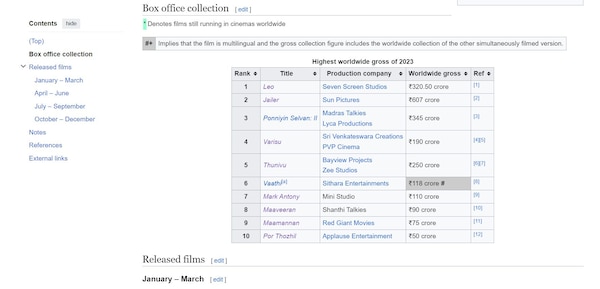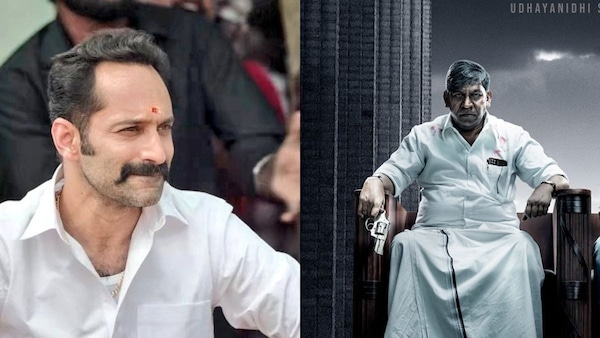2023 box office report — Tamil cinema flexed muscles globally, outshined neighbours, sans a Rs 1000 crore hit
2023 was a great year for Tamil films because never in its rich history it had two films (Jailer and Leo) back-to-back earning more than Rs 600 crore from global box office receipts.

Last Updated: 11.01 AM, Jan 05, 2024
The year 2023 marked the transition in the way audiences judged a film. The debate around a new film shifted from how was the movie? to how much it made? Earlier, fan wars centred around the merits of a movie. Now, it has become a bidding war — the quality of a movie is unimportant as long as it makes more money in comparison to others.
Fans have become fixated on the box office collections of films featuring their favourite stars like never before. If a movie starring Star 'A' outperforms that of Star 'B,' it triggers a fierce response. From relentless online trolling to launching offensive hashtag campaigns on social media and spreading negative reviews, fans go to great lengths to undermine a film or convey that its commercial success is inconsequential.
Take, for example, a Wikipedia page dedicated to the Tamil movies released in 2023. Thalapathy Vijay's latest movie Leo was featured on the top of the 'Highest worldwide gross of 2023' list. Initially, the 'worldwide gross' column showed Rs 620.50 crore, but it was altered to Rs 320.50 crore. Imagine, someone went through all the trouble of editing information on an online encyclopedia to antagonize the star's fans. It doesn't matter that false edits can be quickly reverted and such an exercise in vanity doesn't have any real-world consequences or it doesn't change the actual collections of the aforementioned film. But, it hints at the shrinking space for healthy discussions on movies and the diminishing quality of our pop-cultural discourse. How much a film made or didn't make is the be-all and end-all question. Of late, rarely, do we take a discussion beyond this narrow scope.

But, do such debates really help in elevating the stature of regional film industries domestically and the standing of Indian cinema globally? Is a movie earning Rs 1000 crore or Rs 500 crore an answer to the existential questions facing our film industry? Or is it deepening the crisis?
Tamil cinema created more hits than its other counterparts in the South
In a way, 2023 was a great year for Tamil films because never in its rich history it had two films (Jailer and Leo) back-to-back earning more than Rs 600 crore from global box office receipts. Typically, a Thalapathy Vijay film never grossed more than Rs 330 crore at the box office. However, the collections of Leo almost doubled, with more than Rs 620 crore in ticket sales.
Vijay's market share has grown exponentially with Leo. Superstar Rajinikanth's Jailer also took everyone by surprise with its global collection grossing more than Rs 600 crore.
In 2022, the Kannada films KGF: Chapter 2 and Kantara and the Telugu film RRR cut across the language and cultural barrier and once again highlighted the potential of the domestic box office. That year the two neighbouring industries overshadowed the Tamil film industry, with many wondering whether the latter could ever deliver a "pan-India" hit.
2023 began with this question hanging over the Tamil film industry and many were hoping Mani Ratnam's Ponniyin Selvan 2 and Thalapathy Vijay's Leo would end the fraternity's quest for a Rs 1000 crore box office hit. While this benchmark continues to evade the Tamil film industry, something interesting happened. The industry produced more blockbusters than its neighbours in 2023.
"The market has dramatically opened up for Tamil movies and today the new benchmark is Rs 500 crore," says producer and CEO of Studio Green G Dhananjayan.
The unresolved challenges of Tamil cinema
The popular notion is a South Indian film may not collect upwards of Rs 1000 crore without striking a chord with the patrons in the Hindi-speaking belt. However, this year, Tamil films surprised everyone by breaching the Rs 500 crore threshold without much support from the audiences in the North Indian circuit.
It seems the growing popularity of Tamil films in other parts of the world is making up for its lack of strength in the Hindi belt. "Tamil films are watched in about 30 countries worldwide," notes Dhananjayan underlining the edge that Tamil cinema enjoys over its neighbours in the south.
However, he also tempers the expectations that this sort of success may not come too often. "Every producer aims to achieve this kind of success, but it won't happen every time," he adds.
While Leo and Jailer breached the Rs 600 crore mark at the global box office, there were other handful of movies that brought cheers to local theatres, which seem to be still reeling under the devastation caused by the pandemic two years ago.
This year began on a great note for the stakeholders in Tamil cinema with Vijay's Varisu and Ajith Kumar's Thunivu. Both movies cashed in on the Pongal holiday and became one of the highest-grossing films of this year.
Vaathi, Mark Antony, Maaveeran, Maamannan and Por Thozhil were among the handful of middle-budget films that managed to draw audiences in the theatres. However, the success of these films did not significantly improve the conditions in the industry as the hit-to-flop ratio continues to be higher than ever.
"By the end of 2023, the Tamil film industry will have produced close to 240 films. Of which only 10 percent, which is about 24 movies, might have managed to make profits for the producers, while another 10 percent might have broken even — they were neither a loss nor profitable. And, the remaining 80 percent are likely to be big losses," notes Dhananjayan.
The other stakeholders in the Indian film industry also share Dhananjayan's sentiments.
"This year we didn't have a strong lineup that could fulfil our expectations. The entire December, theatres are running empty. Barring January, the following three months were all pretty dull. So on average, only three months were good for theatres this year, while the remaining nine months were dry and disappointing," rues Tirupur Subramaniam, president of Tamil Nadu Theater and Multiplex Owners Association.

It's safe to assume that a film breaching the Rs 1000 crore mark may make good headlines but it doesn't make a lot of difference to the stakeholders in the value chain if such successes only happen once in a while. "One or two films scoring Rs 500 crore or 1000 crore are no use for theatres. We cannot survive on it," says Subramaniam.
The aftershocks of the pandemic
This is not a problem specific to the Tamil film fraternity. But, it's an existential challenge that members across the Indian film industry are grappling with.
"It is the case of every other industry, films that are doing well go beyond all expectations and those that are not doing well are simply not taking off. You had movies like Jailer and Leo which were exceptional and others didn't even take off. Again, the industry needs to find an equilibrium. After the pandemic, I think this is how the industry is going to be for a while," says Akkshay Rathie who owns Aashirwad Theaters.
The entire Indian film industry has been off-balance for the last few years. In the wake of the pandemic, many wondered whether the audience would ever return to cinemas. And now, it seems the audience will only go through the struggle of going to cinemas when a film offers them something unique. It doesn't always have to be spectacular or out of the world. As we have seen in the last couple of years, even the content that is deemed by many as highly controversial and even outright offensive has managed to sell more tickets than movies made with noble intentions. One of the reasons for this is also many filmmakers still find it challenging to devise the right marketing strategies to create a wide awareness of their films.
The pandemic has shifted the preferences of the audience massively. And this has hurt the mid-segment films that were earlier tasked with the responsibility of keeping the wheels of the box office economy chugging along from one tentpole film to another. "Before the pandemic, an Ayushmann Khurrana movie or Rajkumar Rao movie did certain numbers. After the pandemic, these mid-section movies are not finding as much traction theatrically as they used to. The big-budget tentpole movies are doing big numbers, that's alright. But, what's gone missing is the contribution of mid-segment films. That's hurting the industry," explains Akkshay Rathie.

This year Por Thozhil became the rare small-budget movie that managed to draw audiences in large numbers and exceeded expectations. Films like Dada, Good Night and Irugapatru were among the handful of other small-budget movies that came to the rescue of theatres this year. But, this strike rate is not enough for the industry to grow. "Benchmarks don't define industry, what defines industry is how many films have become hits," says Dhananjayan.
The box office benchmarks are like a double-edged sword. While the films that meet the new standards of commercial success could catapult individual careers to great heights, they seemingly don't make much difference to the entire ecosystem. And also, it adds undue pressure on everyone who operates within it.
Take, for example, Bollywood superstar Salman Khan. He was made to look incompetent because his latest film Tiger 3 didn't not breach a certain benchmark like Jawan or Gadar 2. The film apparently raked in more than Rs 460 crore from its worldwide ticket sales against an estimated budget of Rs 300 crore. But, it was still considered a box-office disappointment in the evolving landscape of the Indian box office.
The changing narrative in Indian cinema
The year 2023 has been a great year for some filmmakers across the Indian film industry. While some films managed to exceed expectations, shatter box office records and set a new benchmark for the industry, many quietly faded away amid the noise created by major blockbusters.
This year we saw the thickening trend of fans and to some extent, the general public, fighting over the box office numbers of certain films. It had even seasoned filmmakers like Mani Ratnam worried. Gone are the days when a film was judged by the quality of its production, storytelling style and so on. The debates about the movie have become very superficial and outright shallow.
In today's times, a cinematic classic is no longer defined by its ability to deeply move audiences, evoke empathy, offer rich human experiences, or connect viewers with latent emotions they might not have known existed within themselves amid the chaos of daily life. The discourse has moved away from the actors' performances, the craftsmanship, and the imagination of creators. Discussions about the intricate layers of human conditions and a film's impact on impressionable minds now seem confined to the peripheries of the internet. The dominant topics of conversation across online platforms revolve around a movie's opening day, opening weekend, and first-week earnings.
But, here's a fun fact, the film industry across the country cannot survive on one or even a few big hits. "There are 52 weeks, and we cannot sustain with four big films. How is it enough? Irrespective of the budget and scale, good films with great entertainment value must come out," opines Subramaniam.
"We need more hits scattered throughout the year. You want films to break the glass ceiling and do Rs 1000 crore. But, you need them to come at great frequency," concludes Akkshay.
In 2024, is it possible for the Indian film industry to strike a balance, allowing mid-segment films to reclaim their lost ground at the box office?

